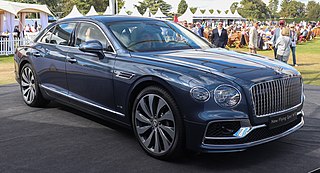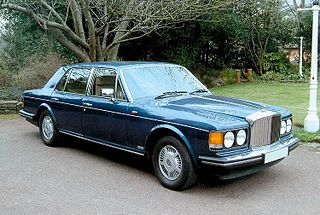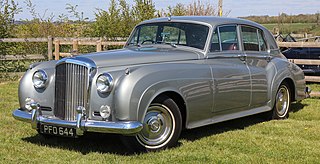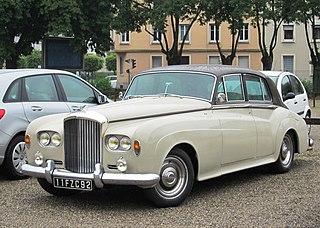 W
WThe Bentley 3 Litre was a car chassis manufactured by Bentley. The company's first, it was developed from 1919 and made available to customers' coachbuilders from 1921 to 1929. The Bentley was very much larger than the 1368 cc Bugattis that dominated racing at the time, but double the size of engine and strength compensated for the extra weight. The 4000 lb (1800 kg) car won the 24 Hours of Le Mans in 1924, with drivers John Duff and Frank Clement, and again in 1927, this time in Super Sports form, with drivers S. C. H. "Sammy" Davis and Dudley Benjafield. Its weight, size, and speed prompted Ettore Bugatti to call it "the fastest lorry in the world", which was regarded as a compliment. Built in 3 main variants, Blue label, Red Label Speed models all carrying a 5-year warranty, and the coveted and rare Green Label 100 mph cars, which only carried a 12-month warranty reflecting the high state of tune.
 W
WThe Bentley 3½ Litre was presented to the public in September 1933, shortly after the death of Henry Royce, and was the first new Bentley model following Rolls-Royce's acquisition of the Bentley brand in 1931.
 W
WThe Bentley 4 Litre was a motor car built on rolling chassis made by Bentley Motors Limited. The 4 litre chassis was conceived and built in a failed attempt to restore Bentley to a good financial state. Announced 15 May 1931, it used a modified four litre Ricardo IOE engine in a shortened 8 litre chassis at two-thirds of the price of the 8 Litre in an attempt to compete with the Rolls-Royce 20/25. Instead, Bentley went into receivership shortly afterward, from which it was purchased by Rolls-Royce Limited.
 W
WThe Bentley 4½ Litre was a British car based on a rolling chassis built by Bentley Motors. Walter Owen Bentley replaced the Bentley 3 Litre with a more powerful car by increasing its engine displacement to 4.4 litres. A racing variant was known as the Blower Bentley.
 W
WThe Bentley 6½ Litre and the high-performance Bentley Speed Six were rolling chassis in production from 1926 to 1930. The Speed Six, introduced in 1928, would become the most successful racing Bentley. Two Bentley Speed Sixes became known as the Blue Train Bentleys after their owner Woolf Barnato's involvement in the Blue Train Races of 1930.
 W
WThe Bentley 8 Litre was a large inline-6 cylinder super-luxury car made in various configurations by Bentley Motors Limited at Cricklewood, London. Announced 15 September 1930, it was also the last completely new model by Bentley before the company's financial collapse and forced sale to Rolls-Royce Limited.
 W
WThe Bentley Arnage is a full-size luxury car manufactured and marketed by Bentley Motors in Crewe, England, from 1998 to 2009. The Arnage and its Rolls-Royce-branded sibling, the Silver Seraph, were introduced in the spring of 1998. They were the first entirely new designs for the two marques since 1980.
 W
WThe Bentley Azure is a four-seater convertible grand tourer produced by British automobile manufacturer Bentley Motors. The first version debuted in 1995 on the Bentley Continental R platform and was made until 2003. After a three-year break, a completely new version debuted in 2006 and was produced until 2009. It was powered by a significantly updated engine and based on the newer Arnage platform.
 W
WThe Bentley Continental GT is a grand tourer manufactured and marketed by British automaker Bentley Motors since 2003. It was the first car released by Bentley under Volkswagen AG management, after the company's acquisition in 1998, and the first Bentley to employ mass production manufacturing techniques.
 W
WThe Bentley Bentayga is a mid-size, front-engine, all-wheel drive, five-door luxury SUV marketed by Bentley, beginning with model year 2016. Its body is manufactured at the Volkswagen Zwickau-Mosel Plant in Germany, then painted by Paintbox Editions in Banbury, England, and finally assembled at Bentley's factory in Crewe, England.
 W
WBentley Brooklands is the name of two distinct models produced by British automobile manufacturer Bentley Motors. The first Brooklands was a full-size luxury saloon, launched in 1992 to replace the Bentley Mulsanne and in turn succeeded by the Bentley Arnage in 1998.
 W
WThe Bentley Brooklands Coupé is a two-door hardtop coupé version of the Bentley Azure convertible. As a hand-assembled car made in very small numbers, employing traditional coach-building techniques and craftsmanship skills in wood and leather, the Brooklands Coupé is the true successor to the discontinued Bentley Continental R and T. Lifetime production is planned for 550 cars, and deliveries started in the first half of 2008.
 W
WBentley Continental refers to several models of cars produced by Bentley Motors. Originally it referred to a special chassis for engines more powerful than the usual offering, supplied to a selected number of coachbuilders for the fitting of very light weight coachwork designed under Rolls-Royce supervision.
 W
WThe Bentley Flying Spur is a luxury saloon produced by Bentley Motors Limited since 2005, and was released since 2006. It is the four-door variant of the Bentley Continental GT coupé.
 W
WThe Bentley Continental GT is a grand tourer manufactured and marketed by British automaker Bentley Motors since 2003. It was the first car released by Bentley under Volkswagen AG management, after the company's acquisition in 1998, and the first Bentley to employ mass production manufacturing techniques.
 W
WThe Bentley Continental GT is a grand tourer manufactured and marketed by British automaker Bentley Motors since 2003. It was the first car released by Bentley under Volkswagen AG management, after the company's acquisition in 1998, and the first Bentley to employ mass production manufacturing techniques.
 W
WThe Bentley Continental R was a luxury coupé manufactured by British automobile manufacturer Bentley Motors from 1991 to 2003. It was the first Bentley to feature a body not shared with a Rolls-Royce model since the 1965 S3 Continental and was the first to use the GM 4L80-E transmission. The Continental R was the fastest, most expensive, and most powerful Bentley automobile of its day. It was also the most expensive production car in the world at its introduction. A convertible derivative, called the Bentley Azure, was launched in 1995.
 W
WThe Bentley Continental R was a luxury coupé manufactured by British automobile manufacturer Bentley Motors from 1991 to 2003. It was the first Bentley to feature a body not shared with a Rolls-Royce model since the 1965 S3 Continental and was the first to use the GM 4L80-E transmission. The Continental R was the fastest, most expensive, and most powerful Bentley automobile of its day. It was also the most expensive production car in the world at its introduction. A convertible derivative, called the Bentley Azure, was launched in 1995.
 W
WThe Bentley Continental R was a luxury coupé manufactured by British automobile manufacturer Bentley Motors from 1991 to 2003. It was the first Bentley to feature a body not shared with a Rolls-Royce model since the 1965 S3 Continental and was the first to use the GM 4L80-E transmission. The Continental R was the fastest, most expensive, and most powerful Bentley automobile of its day. It was also the most expensive production car in the world at its introduction. A convertible derivative, called the Bentley Azure, was launched in 1995.
 W
WThe Rolls-Royce Corniche is a two-door, front-engine, rear wheel drive luxury car produced by Rolls-Royce Motors as a hardtop coupé and as a convertible.
 W
WThe Eight was Bentley's "entry-level" offering from 1984 until 1992. Distinguished mainly by a wire-mesh grille radiator instead of vertical slats, the Eight also had somewhat less equipment than the similar Mulsanne on which it was based. This brought the introductory price to under the psychologically important £50,000 mark at the time of introduction, £6,000 less than the Mulsanne. A firmer suspension offered slight handling improvements. The Eight was so popular that sales expanded from the original UK market to Europe and the United States.
 W
WThe Bentley Mark V was Rolls-Royce's second Bentley model. Intended for announcement at the Earl's Court Motor Show set down for late October 1939 it had much in common with its predecessor. War was declared on 3 September 1939 and a few days later Bentley announced it had ceased production of civilian items.
 W
WThe Bentley Mark VI is an automobile from Bentley which was produced from 1946 to 1952.
 W
WThe Bentley Mulsanne is a performance luxury car which was produced by Bentley Motors Limited from 1980 until 1992, though derivative models like the Continental T and Azure continued in production into the 2000s. The name "Mulsanne" is derived from Bentley's motorsport history, which included five victories at the 24 Hours of Le Mans between 1924 and 1930 — the 'Mulsanne Straight' being the stretch of the Le Mans racecourse where cars reach their highest speeds.
 W
WThe Bentley Mulsanne is a full-size luxury car that was manufactured by Bentley from 2010 to 2020. The car is named after the Mulsanne Corner of the Le Mans racing circuit, where Bentley race cars have won six times in the 24 hours racing format. Considered one of the few vehicles entirely developed internally at Bentley, the Mulsanne did not share a platform with vehicles from Rolls-Royce or Volkswagen Group.
 W
WThe Bentley R Type is the second series of post-war Bentley automobiles, replacing the Mark VI. Essentially a larger-boot version of the Mk VI, the R type is regarded by some as a stop-gap before the introduction of the S series cars in 1955. As with its predecessor, a standard body was available as well as coachbuilt versions by firms including H. J. Mulliner & Co., Park Ward, Harold Radford, Freestone and Webb, Carrosserie Worblaufen and others.
 W
WThe Bentley S1 was a luxury car produced by Bentley Motors Limited from 1955 until 1959. The S1 was derived from Rolls-Royce's complete redesign of its standard production car after World War II, the Silver Cloud. Each was its maker's last standard production car with an independent chassis. The S-series Bentley was given the Rolls-Royce - Bentley L Series V8 engine in late 1959 and named the S2. Twin headlamps and a facelift to the front arrived in late 1962, resulting in the S3. In late 1965 the S3 was replaced by the new unitary construction Rolls-Royce Silver Shadow-derived T series.
 W
WThe Bentley S2 is a luxury car produced by Bentley from 1959 until 1962. The successor to the S1, it featured the new Rolls-Royce - Bentley L Series V8 engine and improved air conditioning made possible by that engine's increased output. Power steering was also standard, and a new dashboard and steering wheel were introduced. Some early S2s were built with the earlier S1 dashboard.
 W
WThe Bentley S3 is a four-door luxury car produced by Bentley from late 1962 until 1965.
 W
WThe Bentley State Limousine is an official state car manufactured by Bentley for Queen Elizabeth II on the occasion of her Golden Jubilee in 2002. Only two were built and both are in the Royal Mews.
 W
WThe Bentley T-series is a luxury automobile produced by Bentley Motors Limited in the United Kingdom from 1965 to 1980. It was announced and displayed for the first time at the Paris Motor Show on 5 October 1965 as a Bentley-badged version of the totally redesigned Rolls-Royce Silver Shadow.
 W
WThe Bentley Turbo R is a high-performance automobile which was produced by Bentley Motors Limited from 1985 to 1999. The "R" stood for "roadholding", to set it apart from its predecessor. It initially inherited the turbocharged engine from the Mulsanne Turbo and also sported a retuned suspension and wider tires on alloy wheels, a first for a Bentley. From the 1987 model year, however, the Turbo R's V8 engine was retuned with fuel injection for added torque. Motor Trend called the Turbo R "the first Bentley in decades deserving of the famous name" in their review of the car on its introduction to the United States in 1989.
 W
WThe Bentley Turbo R is a high-performance automobile which was produced by Bentley Motors Limited from 1985 to 1999. The "R" stood for "roadholding", to set it apart from its predecessor. It initially inherited the turbocharged engine from the Mulsanne Turbo and also sported a retuned suspension and wider tires on alloy wheels, a first for a Bentley. From the 1987 model year, however, the Turbo R's V8 engine was retuned with fuel injection for added torque. Motor Trend called the Turbo R "the first Bentley in decades deserving of the famous name" in their review of the car on its introduction to the United States in 1989.
 W
WThe Bentley Turbo R is a high-performance automobile which was produced by Bentley Motors Limited from 1985 to 1999. The "R" stood for "roadholding", to set it apart from its predecessor. It initially inherited the turbocharged engine from the Mulsanne Turbo and also sported a retuned suspension and wider tires on alloy wheels, a first for a Bentley. From the 1987 model year, however, the Turbo R's V8 engine was retuned with fuel injection for added torque. Motor Trend called the Turbo R "the first Bentley in decades deserving of the famous name" in their review of the car on its introduction to the United States in 1989.